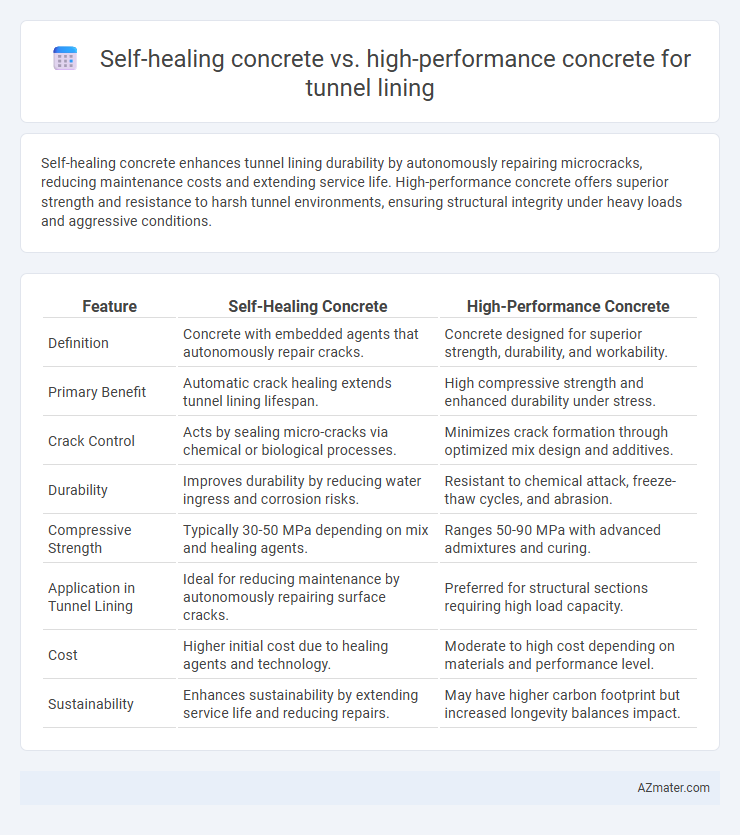Self-healing concrete enhances tunnel lining durability by autonomously repairing microcracks, reducing maintenance costs and extending service life. High-performance concrete offers superior strength and resistance to harsh tunnel environments, ensuring structural integrity under heavy loads and aggressive conditions.
Table of Comparison
| Feature | Self-Healing Concrete | High-Performance Concrete |
|---|---|---|
| Definition | Concrete with embedded agents that autonomously repair cracks. | Concrete designed for superior strength, durability, and workability. |
| Primary Benefit | Automatic crack healing extends tunnel lining lifespan. | High compressive strength and enhanced durability under stress. |
| Crack Control | Acts by sealing micro-cracks via chemical or biological processes. | Minimizes crack formation through optimized mix design and additives. |
| Durability | Improves durability by reducing water ingress and corrosion risks. | Resistant to chemical attack, freeze-thaw cycles, and abrasion. |
| Compressive Strength | Typically 30-50 MPa depending on mix and healing agents. | Ranges 50-90 MPa with advanced admixtures and curing. |
| Application in Tunnel Lining | Ideal for reducing maintenance by autonomously repairing surface cracks. | Preferred for structural sections requiring high load capacity. |
| Cost | Higher initial cost due to healing agents and technology. | Moderate to high cost depending on materials and performance level. |
| Sustainability | Enhances sustainability by extending service life and reducing repairs. | May have higher carbon footprint but increased longevity balances impact. |
Introduction to Tunnel Lining Materials
Self-healing concrete incorporates microcapsules or bacteria that autonomously repair cracks, enhancing durability and reducing maintenance in tunnel linings. High-performance concrete (HPC) offers superior strength, durability, and resistance to environmental stressors, making it a reliable choice for tunnel lining under high load conditions. Both materials address critical challenges in tunnel construction, with self-healing concrete improving longevity and HPC ensuring structural integrity.
Overview of Self-Healing Concrete
Self-healing concrete for tunnel lining incorporates encapsulated healing agents or bacteria that activate upon crack formation, sealing fissures autonomously and enhancing structural durability. This innovative material reduces maintenance frequency and extends the lifespan of underground infrastructure by mitigating water ingress and corrosion risks. Compared to high-performance concrete, which offers superior mechanical strength and durability through optimized mix design and additives, self-healing concrete uniquely addresses longevity through active crack repair mechanisms.
Overview of High-Performance Concrete
High-performance concrete (HPC) for tunnel lining offers superior strength, durability, and resistance to environmental stressors compared to conventional concrete, making it ideal for demanding underground conditions. HPC typically includes optimized mix designs with supplementary cementitious materials such as silica fume or fly ash, enhancing its mechanical properties and reducing permeability. This results in extended service life and reduced maintenance costs, critical factors for infrastructure longevity in tunnel applications.
Key Material Properties Comparison
Self-healing concrete in tunnel lining offers enhanced durability by autonomously repairing micro-cracks through embedded healing agents, significantly extending structural lifespan and reducing maintenance costs. High-performance concrete excels with superior compressive strength, low permeability, and increased resistance to chemical attacks, providing robust structural integrity under extreme tunnel conditions. Both materials improve tunnel safety, but self-healing concrete emphasizes long-term crack mitigation while high-performance concrete focuses on immediate mechanical strength and durability.
Durability and Crack Resistance
Self-healing concrete enhances tunnel lining durability by autonomously repairing micro-cracks, reducing maintenance costs and extending service life under harsh underground conditions. High-performance concrete offers superior mechanical strength and chemical resistance, ensuring structural integrity and crack resistance against environmental stresses but lacks intrinsic repair capabilities. Combining self-healing additives with high-performance concrete formulations optimizes durability and crack mitigation in tunnel linings subjected to dynamic loads and aggressive agents.
Maintenance and Lifecycle Costs
Self-healing concrete significantly reduces maintenance costs for tunnel lining by automatically sealing microcracks, preventing water ingress and corrosion, which extends the structure's service life. High-performance concrete offers enhanced strength and durability but requires periodic inspections and repairs to address cracking and degradation, increasing lifecycle costs. The reduced frequency of repairs with self-healing concrete translates into lower overall lifecycle expenses despite its higher initial material cost.
Environmental and Sustainability Considerations
Self-healing concrete enhances sustainability in tunnel lining by autonomously repairing cracks, reducing the need for frequent maintenance and extending the structure's lifespan, which lowers resource consumption and carbon emissions. High-performance concrete offers superior strength and durability, enabling thinner linings that decrease material use but involves higher embodied energy due to its advanced mix design. Selecting self-healing concrete can significantly minimize environmental impact through reduced repair cycles, while high-performance concrete contributes by optimizing structural efficiency in tunnel construction.
Real-world Applications and Case Studies
Self-healing concrete in tunnel lining has been effectively utilized in projects such as the James Dyson Tunnel in the UK, where microcapsule-based healing agents reduced maintenance costs by autonomously repairing microcracks and enhancing durability. High-performance concrete (HPC), with its superior compressive strength and low permeability, has been prominently applied in the Gotthard Base Tunnel, Switzerland, ensuring long-term structural integrity under high-stress conditions. Case studies demonstrate that while HPC excels in structural performance, self-healing concrete offers innovative maintenance benefits by extending service life and minimizing repair interventions in underground infrastructure.
Challenges and Limitations
Self-healing concrete for tunnel lining faces challenges such as limited healing efficiency under extreme pressures and the high cost of incorporating microcapsules or bacteria-based agents. High-performance concrete offers superior mechanical strength and durability but may suffer from brittleness and complex mix designs that hinder large-scale application in irregular tunnel geometries. Both materials struggle with long-term performance verification and maintenance in harsh subterranean environments.
Future Trends in Tunnel Lining Technology
Self-healing concrete offers significant advancements in tunnel lining technology by autonomously repairing micro-cracks, reducing maintenance costs and extending service life compared to traditional high-performance concrete. Innovations in material science integrate bacterial spores or encapsulated healing agents, enhancing durability and resilience in harsh tunnel environments. Future trends emphasize hybrid applications combining the strength and longevity of high-performance concrete with the adaptive self-repair capabilities of self-healing composites to improve tunnel safety and sustainability.

Infographic: Self-healing concrete vs High-performance concrete for Tunnel lining
 azmater.com
azmater.com